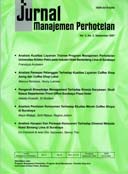PENGARUH LINGKUNGAN FISIK TERHADAP IMPRESI KONSUMEN PADA KEDAI KOPI KEKINIAN DI SURABAYA
 :
:
https://doi.org/10.9744/jmp.7.1.42-48
Keywords:
Ambience, Layout, Facility Aesthetic, Impresi Konsumen, Kedai Kopi KekinianAbstract
Penelitian ini bertujuan untuk mengetahui pengaruh lingkungan fisik yang terdiri dari ambience, layout dan facility aesthetic terhadap impresi konsumen pada kedai kopi kekinian yang ada di Surabaya. Metode yang di gunakan dalam penelitian ini menggunakan analisa regresi linier berganda dengan total responden sebanyak 149. Hasil dari penelitian menunjukan bahwa terdapat hubungan yang positif dan signifikan pada lingkungan fisik terhadap impresinya pada konsumen kedai kopi di Surabaya.
References
Alfirahmi, A. (2019). Fenomena kopi kekinian di era 4.0 ditinjau dari marketing 4.0 dan teori uses and effect. LUGAS Jurnal Komunikasi, 3(1), 24-32.
Arikunto, S. (2006). Prosedur penelitian suatu pendekatan praktik. Jakarta: Rineka Cipta.
Bitner, M. J. (1992). Servicescapes: The Impact of Physical Surroundings on Customers and Employees. Journal of Marketing, 56(2), 57-71
Blanchard, R. (2005). The digital challenge for libraries: Understanding the culture and technology of total information. Universe.
Crespo, C. J. (1998, March). Update on national data on asthma. Paper presented at the meeting of the National Asthma Education and Prevention Program, Leesburg, VA.
Erinda, A. & Kumadji, S. (2016). Analisis faktor-faktor preferensi pelanggan dan pengaruhnya terhadap keputusan pembelian (Studi Terhadap Pelanggan McDonald’s di Indonesia dan Malay-sia). Jurnal Administrasi Bisnis, 30(1), 87-95.
Cohen, & Swerdlik. (2009). Psychological testing & assessment: An introduction to tests & measurement. United States of America: McGraw-Hill.
Country, C. C. & Jang, S.C. (2006). The effects of atmospheric elements on customer impression: the case of hotel lobbies. International Journal of Contemporary Hospitality Management, 18(7), 534-545.
Durna, U., Dedeoglu, B. B., & Balikçioglu, S. (2015). The role of servicescape and image perceptions of customers on behavioral intentions in the hotel industry. International Journal of Contemporary Hospitality Management, 27(7), 1728-1748.
Falkner, L. (2020). An exploratory study of generational coffee preferences.
Ferdinand, A. T (2006). Metode penelitian manaje-men: pedoman penelitian untuk skripsi. Tesis dan Disertasi Ilmu Manajemen. Semarang: Univer-sitas Diponegoro.
Ghozali, I. (2012.) Aplikasi Analisis Multivariate dengan Program IBM SPSS. Yogyakarta: Universitas Diponegoro
Gumiwang, R. & Syafina, D. C. (2019, December 17). Pasar Bisnis Kedai Kopi di Indonesia Sudah Tembus Rp 4,8 triliun. Retrieved from https://tirto.id/pasar-bisnis-kedai-kopi-di-indone-sia-sudah-tembus-rp48-triliun-enBQ
Hamilton, I. S. (2007). Dictionary of psychological testing: assessment and treatment. London; Philadelphia: Jessica Kingsley.
Jani, D. & Han, H. (2014). Personality, satisfaction, image, ambience, and loyalty: Testing their relationships in the hotel industry. International Journal of Hospitality Management, 18(7), 534-545.
Jogiyanto, & Abdillah, W. (2009). Konsep dan Apli-kasi PLS (Partial Least Square) untuk Penelitian Empiris. Yogyakarta: BPFE.
Khan, M. A. (2006). Consumer behaviour and advertising management. New Age International (P).
Kuncoro, M. (2003), Metode Riset untuk Bisnis & Ekonomi, BagaimanaMeneliti & Menulis Tesis, Erlangga, Jakarta.
Kotler, P. (1973). Atmospherics as a marketing tool. Journal of Retailing, 49(4), 48-64.
Kotler, P. 1997. Manajemen Pemasaran Analisis, Perencanaan, Implementasi dan Kontrol. Jakarta: PT. Prehallindo.
Kopi di Indonesia, Sejarah Singkat Tentang Proses Penyebarannya di Negeri Ini. (2019, March 19). Retrieved from https://jurnalbumi.com/knol/ sejarah-kopi/
Kaçan, U. & Erdoğan, H. H. (2017, June). A culinary tourism innovation: The fourth wave of coffee. Paper presented at 9th World Conference for Graduate Research in Tourism Hospitality and Leisure, Cartagena, Spain.
Liana, L. (2009). Penggunaan MRA dengan SPSS untuk menguji pengaruh variabel moderating terhadap hubungan antara variabel independen dan variabel dependen. Dinamik, 14(2).
Lin, I. Y., & Mattila, A. S. (2010). Restaurant service-scape, service encounter, and perceived congruency on customers' emotions and satisfaction. Journal of hospitality marketing & management, 19(8), 819-841.
Muhammad, A., & Sungplee, S. (2015). Factors of Customer’s Preference of Visiting Coffee Shop in South Korea. International Journal of Scie-nces: Basic and Applied Research, 24, 252-265.
Pindyck, R. S. & Rubinfeld, D. L. (2009). Micro-economics. Upper Saddle River, N.J: Pearson/ Prentice Hall.
Prasetyo, B., & Jannah, L. M. (2005). Metode peneliti-an kuantitatif: teori dan aplikasi. Jakarta. Raja Grafindo Persada.
Ryu, K. & Jang, S. S. (2007). The effect of environmental perceptions on behavioral intentions through emotions: The case of upscale restaurants. Journal of Hospitality & Tourism Rese¬arch, 31(1), 56-72.
Santoso, S., & Tjiptono, F. (2001). Riset Pemasaran: konsep dan aplikasi dengan SPSS. PT. Elex Media Komputindo, Jakarta.
Setiadi, N. J. (2003). Perilaku konsumen: Konsep dan implikasi untuk strategi dan penelitian pemasaran. Jakarta: Prenada Media
Sugiyono. (2013). Metode Penelitian Kuantitatif, Kualitatif dan R&D. Bandung: Alfabeta.CV
Santoso, P. B., & Ashari. (2005). Analisis statistik dengan microsoft excel dan SPSS. Yogyakarta: Andy Publisher.
Shahbandeh, M. (2019, February 14). Top coffee producing countries 2018. Retrieved from https://www.statista.com/statistics/277137/world-coffee-production-by-leading-countries/
Simamora, B. 2003. Panduan Riset Perilaku Konsu-men, Penerbit PT. Gramedia Pustaka Utama, Jakarta.
Sularso, S. (2003). Buku Pelengkap Metode Penelitian Akuntansi Sebuah Pendekatan Replikasi. Edisi Revisi 2003/2004. Yogyakarta: BPFE Yogyakarta.
Tedeschi, J. T. (1984). Impression management theory and social psychological research. Acad. Press.
Toffin. (2020). 2020 Brewing In Indonesia: Insights for Successful Coffee Shop Business.
Wakefield, K. L., & Blodgett, J. G. (1994). The Importance of Servicescapes in Leisure Service Settings. Journal of Services Marketing, 8(3), 66-76.
Widiati, S. (2020, June 30). The Emerging Business of Coffee Shops in Indonesia. Retrieved from https://nowjakarta.co.id/dining/culinary-talk/the-emerging-business-of-coffee-shops-in-indonesia.


















